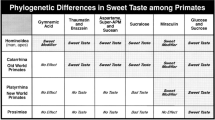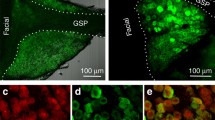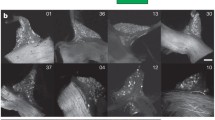Summary
-
1.
The ramus recurrens facialis (VII) innervating the flank of the channel catfish,Ictalurus punctatus, responded to both amino acid (Fig. 2–10; Table 1) and mechanical (Fig. 11) stimulation of the flank skin.
-
2.
The integrated phasic gustatory responses generally increased exponentially with logarithmic increase in stimulus concentration over a wide concentration range with a tendency for saturation at concentrations ≧10−4.5 M (Fig. 6).
-
3.
l-alanine andl-arginine HCl were the most stimulatory compounds tested, with thresholds averaging 10−8.6±0.4m (M±SE) (Fig. 4; Table 1).
-
4.
Cross-adaptation experiments suggest that alanine and arginine bind to relatively independent receptor sites on the taste cells (Fig. 10; Table 1); further, single-unit studies indicate the recurrent nerve is composed of at least two types of amino acid sensitive taste fibers, alanine-best and arginine-best fibers (Fig. 8). In general, unit responses were consistent with the multiunit data (Table 1).
-
5.
Taste fibers of the recurrent nerve are relatively insensitive to sodium chloride and sucrose; generally, responses were obtained to quinine hydrochloride and hydrochloric acid, but only at relatively high stimulus concentrations (≧10−4 M, Fig. 7).
-
6.
Taste responses of the recurrent nerve are similar to the results obtained from maxillary barbel taste recordings in the same species (Caprio 1975, 1978), suggesting an analogous chemical response profile of facially innervated taste buds irrespective of their anatomical location in the catfish.
-
7.
Intra-cranial neural recordings from the recurrent nerve indicate that the tactile responsiveness observed in the present experiments was not attributable to spinal innervation of the flank. The size and contour of the mechanoreceptive flank region innervated by teased bundles of the recurrent nerve varied greatly; some single units responded to both chemical and mechanical stimuli (Fig. 11).
Similar content being viewed by others
Abbreviations
- LLac accessory :
-
lateral line nerve
References
Atema J (1971) Structures and functions of the sense of taste in the catfish (Ictalurus natalis). Brain Behav Evol 4:273–294
Bardach JE, Case J (1965) Sensory capabilities of the modified fins of Squirrel hake (Urophycis chuss) and Searobins (Prionotus carolinus andP. evolans). Copeia 2:194–206
Bardach JE, Fujiya M, Holl A (1967a) Investigations of external chemoreceptors of fishes. In: Hayashi T (ed) Olfaction and taste, vol II. Pergamon Press, Elmsford, NY pp 647–665
Bardach JE, Todd JH, Crickmer R (1967b) Orientation by taste in fish of the genusIctalurus. Science 155:1276–1278
Biedenbach MA (1973) Functional properties and projection areas of cutaneous receptors in catfish. J Comp Physiol 84:227–250
Cagan RH, Rhein LD (1980) Biochemical basis of recognition of taste and olfactory stimuli. In: Starre H van der (ed) Olfaction and taste, vol VII. I.R.L. Press, Washington, DC, pp 35–44
Cagan RH, Teeter JH (1980) Selective inhibition of binding to a taste receptor site. Soc Neurosci Abstr 6:304
Caprio J (1975) High sensitivity of catfish taste receptors to amino acids. Comp Biochem Physiol [A] 52:247–251
Caprio J (1978) Olfaction and taste in the channel catfish: an electrophysiological study of the responses to amino acids and derivatives. J Comp Physiol 123:357–371
Caprio J (1980) Similarity of olfactory receptor responses (EOG) of freshwater and marine catfish to amino acids. Can J Zool 58:1773–1784
Caprio J (1982) High sensitivity and specificity of olfactory and gustatory receptors of catfish to amino acids. In: Hara TJ (ed) Chemoreception in fishes. Elsevier, New York, pp 109–134
Caprio J, Tucker D (1976) Specialist and generalist taste fibers in the catfish. Soc Neurosci Abstr. 2:152
Finger TE (in press) The gustatory system in teleost fish. In: Northcutt RG, Davis RE (ed) Fish neurobiology and behavior, vol I. University of Michigan Press, Ann Arbor, Michigan
Freihofer WC (1963) Patterns of the ramus lateralis accessorius and their systematic significance in teleostean fishes. Stanford Ichthyol Bull 8:89–189
Fujiya M, Bardach JE (1966) A comparison between the external taste sense of marine and freshwater fishes. Bull Jpn Soc Sci Fish 32:45–56
Goh Y, Tamura T (1980) Olfactory and gustatory responses to amino acids in two marine teleosts — red sea bream and mullet. Comp Biochem Physiol [C] 66:217–224
Herrick CJ (1901) The cranial nerves and cutaneous sense organs of the North American siluroid fishes. J Comp Neurol 11:177–249
Herrick CJ (1904) The organ and sense of taste in fishes. Bull US Fish Commis 22:237–272
Hidaka I, Kiyohara S, Tabata M, Yonezawa K (1975) Gustatory responses in the puffer. Bull Jpn Soc Sci Fish 41:275–281
Hidaka I, Ohsugi T, Kubomatsu T (1978) Taste receptor stimulation and feeding behavior in the puffer,Fugu pardalis. I. Effect of single chemicals. Chem Senses Flavor 3:341–354
Hoagland H (1932) Impulses from sensory nerves of catfish. Proc Natl Acad Sci USA 18:701–705
Holland KN, Teeter JH (1981) Behavioral and cardiac reflex assays of the chemosensory acuity of channel catfish to amino acids. Physiol Behav 27:699–707
Johnsen PB, Teeter JH (1980) Spatial gradient detection of chemical cues by catfish. J Comp Physiol 140:95–99
Kaku T, Tsumagari M, Kiyohara S, Yamashita S (1980) Gustatory responses in the minnow,Pseudorasbora parva. Physiol Behav 25:99–105
Kasahara Y, Kawamura Y (1975) Mechano-sensitive afferent fibers in the chorda tympani. J Physiol Soc Jpn 37:286
Katsuki Y, Hashimoto J, Kendall I (1971) The chemoreception in the lateral-line organs of teleosts. Jpn J Physiol 21:99–118
Kiyohara S, Tucker D (1978) Activity of new receptors after transection of the primary olfactory nerve in pigeons. Physiol Behav 21:987–994
Kiyohara S, Hidaka I, Tamura T (1975a) Gustatory response in the puffer II. Single fiber analysis. Bull Jpn Soc Sci Fish 41:383–391
Kiyohara S, Hidaka T, Tamura T (1975b) The anterior cranial gustatory pathway in fish. Experientia 31:1051–1053
Kiyohara S, Yamashita S, Harada S (1981) High sensitivity of minnow gustatory receptors to amino acids. Physiol Behav 26:1103–1108
Konishi J, Hidaka I (1967) Stimulation of the chemoreceptors of the sea catfish by dilute electrolyte solutions. Jpn J Physiol 17:726–737
Konishi J, Zotterman Y (1961) Taste functions in the carp. Acta Physiol Scand 52:150–161
Konishi J, Uchida M, Mori Y (1966) Gustatory fibers in the sea catfish. Jpn J Physiol 16:194–204
Little EE (1981) Conditioned cardiac response to the olfactory stimuli of amino acids in the channel catfish,Ictalurus punctatus. Physiol Behav 27:691–697
Martin AR, Wickelgren WO (1971) Sensory cells in the spinal cord of the sea lamprey. J Physiol (Lond) 212:65–83
Marui T, Funakoshi M (1979) Tactile input to the facial lobe of the carp,Cyprinus carpio L. Brain Res 177:479–488
Peters RC, Loop WJG, Gerritsen A (1974) Distribution of electroreceptors, bioelectric field patterns, and skin resistance in the catfish,Ictalurus nebulosus Les. J Comp Physiol 92:11–22
Pfaffmann C (1978) The vertebrate phylogeny, neural code, and integrative processes of taste. In: Carterette EC, Freidman MP (ed) Handbook of perception, tasting and smelling, vol VIA. Academic Press, N.Y. pp 51–123
Reutter K (1978) Taste organ in the bullhead (Teleostei). Adv Anat Embryol Cell Biol 55:1–98
Roberts A, Hayes BP (1977) The anatomy and function of ‘free’ nerve endings in an amphibian skin sensory system. Proc R Soc Lond [Biol] 196:415–429
Silver WL (1979a) Electrophysiological responses from the olfactory system of the American eel. PhD dissertation, Florida State University, Tallahassee, Florida USA
Silver WL (1979b) Olfactory responses from a marine elasmobranch, the Atlantic stingray,Dasyatus sabina. Mar Behav Physiol 6:297–305
Sokal RR, Rohlf FJ (1969) Biometry. The principles and practice of statistics in biological research. Freeman, San Francisco, pp 1–776
Späth M, Schweickert W (1977) The effect of metacaine (MS-222) on the activity of the efferent and afferent nerves in the teleost lateral-line system. Arch Pharmacol 297:9–16
Stevens SS (1957) On the psychophysical law. Psychol Rev 64:153–181
Stewart A, Bryant B, Atema J (1979) Behavioral evidence for two populations of amino acid receptors in catfish taste. Biol Bull 157:396
Sutterlin AM, Sutterlin N (1970) Taste responses in Atlantic salmon (Salmo salar) Parr. J Fish Res Board Can 27:1927–1942
Sutterlin AM, Sutterlin N (1971) Electrical responses of the olfactory epithelium of Atlantic salmon (Salmo salar). J Fish Res Board Can 28:565–572
Suzuki N, Tucker D (1971) Amino acids as olfactory stimuli in freshwater catfish,Ictalurus catus (L). Comp Biochem Physiol[A] 40:399–404
Suzuki N (1978) Effects of different ionic environments on the responses of single olfactory receptors in the lamprey. Comp Biochem Physiol 41:461–467
Tateda H (1961) Response of catfish barbels to taste stimuli. Nature 192:343–344
Tateda H (1964) The taste response of the isolated barbel of the catfish. Comp Biochem Physiol 11:367–378
Yamane S (1978) Influence of ions and chemical substances on the response of the frog's tongue to mechanical stimulation. Comp Biochem Physiol [A] 61:451–459
Yoshii K, Kamo N, Kurihara K, Kobatake Y (1979) Gustatory responses of eel palatine receptors to amino acids and carboxylic acids. J Gen Physiol 74:301–317
Author information
Authors and Affiliations
Rights and permissions
About this article
Cite this article
Davenport, C.J., Caprio, J. Taste and tactile recordings from the ramus recurrens facialis innervating flank taste buds in the catfish. J. Comp. Physiol. 147, 217–229 (1982). https://doi.org/10.1007/BF00609846
Accepted:
Issue Date:
DOI: https://doi.org/10.1007/BF00609846




